|
The
plot of our film today is simple enough:
When three small town California school
teachers drive across the desert to Los Angeles for a baseball
game, along a lonely stretch of road, they come upon a homestead/service-station/salvage yard in the middle of
nowhere; and since their car's engine has developed
a serious hiccup, the driver, Ed
Stiles (Richard
Alden), pulls in to hopefully have
it diagnosed and fixed. No one greets them,
but, it being the weekend
and all, they just assume the station is
closed.
With
nothing else to do while Stiles tinkers
with the fuel-pump on his own, Carl Oliver (Don
Russell) and Doris Page (Helen
Hovey) start exploring the rows of
old derelict cars and empty buildings ... As
they wander about, there are plenty of
foreboding clues that something isn't
quite right -- an empty table with a meal
uneaten, a phone off the hook -- and as
these ominous clues add up, we can't help
but conclude that something sinister is
afoot. Alas, our three heroes are too slow
to put all these effects together before
they're all staring down the barrel of a
.45 automatic...
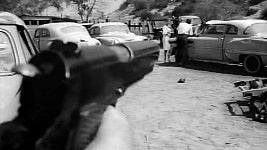
I
freely admit as a Nebraskan, we as a
state, an entire entity, have an
inferiority complex. We hayseeds and
shit-kickers have a chip on our shoulder
the size of Lake McConaughy (--
buy a map!) and rabidly defend our
place in the union by hoping our lack of
uniqueness somehow makes us unique. What
else do we have to be proud of? Our
biggest claim to fame is having one of the
dullest stretches of any Interstate;
Johnny Carson, Marlon Brando, Henry Fonda,
James
Coburn, and a lot of other famous people
were born here (-- but I point out
they all left); and the
schizophrenic weather, with all four
seasons known to occur within the span of
a few minutes, aren't really
tourist attractions, either.
And
then there's that whole Charlie
Starkweather thing. E'yup, we had the
nations first fugitive spree killer. Yay
us. For those few who are unfamiliar
with this yahoo, back in 1958, nineteen
year-old Starkweather and Caril Fugate,
his fourteen year-old girlfriend,
terrorized the nation's heartland as they
blazed a trail through five states,
leaving another trail of dead bodies
behind them -- eleven people all together,
including
Fugate's parents and baby sister, whom
Chuckles beat to death -- before
finally being caught. My mother, who was
twelve years old when these two were
running amok, honestly doesn't like
talking about it all that much; it scared
her pretty good. What little she
recollected was that the deadly couple were
[allegedly] spotted in the nearby town of
Hastings at one point -- as I'm sure they
were [allegedly spotted] in
every town at the time, and how her folks
kept both doors locked and a shotgun, also
locked and loaded, stationed by each.
Everyone was scared, for this was a whole
different kind of gun nut than, say,
outlaw bandits like Bonnie and Clyde, or
John Dillinger, who came before them.
After they were finally caught, Fugate
turned against her boyfriend, claiming to
be a hostage the whole time, but nobody
bought her story. For their crimes,
Starkweather got the electric chair, Fugate got a life sentence, and teenage
delinquency had taken a new, and
dangerously lethal turn. And advocates against
things like rock and roll music, violence
in the media, and the decline of moral
values had a new poster couple to vilify
as a new phrase entered our pop-culture
lexicon: the thrill-killer.
Over
the subsequent years, Starkweather and
Fugate's homicidal relationship served as
the basis for several films, most notably
Terrence Mallick's Badlands,
and its influence spawned a whole genre in
the 1990's about trailer-trash with guns
with films like Kalifornia
and Oliver Stone's Natural
Born Crackers
-- erk, I mean, Natural
Born Killers.
Still, Badlands
debuted almost fifteen years after
Charlie got the chair. Seems mainstream
Hollywood was reluctant to tackle the sore
subject of this new breed of mass
murderer; and while they wouldn't touch
the likes of Starkweather, Richard Speck
or Charles Whitman with a ten-foot pole,
many a smaller, independent production
companies were, forgive me, quicker on the
trigger. And one
of the first fledgling adaptations came
out in 1963 by the anti-dynamic duo of
Arch Hall2 -- a/k/a Arch
Hall Sr. and Arch Hall Jr. And judging by
what they'd done before, cinematically
speaking, you never would have guessed
they'd have this good a movie in them.
Coming on the heels of EEGAH!,
their
giant caveman on the loose epic,
came this criminally underrated gem of a
film: an honest study in unbridled
brutality and mounting terror called The
Sadist.
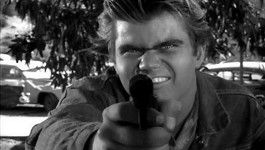
Now,
the
finger on the trigger of that .45
automatic I described earlier belongs to
Charlie Tibbs (Arch
Hall Jr.), a thug of the highest
caliber. With his jailbait girlfriend,
Judy Bradshaw (Marilyn Manning)
on his arm, Tibbs starts to torment this
hapless trio of travelers. Doing her best
to encourage him, Judy constantly whispers
into his ear, egging him on, and giving
him ideas that are the equivalent of
somebody pulling the wings off of a fly
before squashing it. Quite obviously,
Charlie relishes his position of power,
especially when he finds out his latest
batch of victims are all
teachers -- and is amped up even more by
the cowed reaction of his captive
audience.
Stiles
realizes first that these two are the
spree-killers that have been making
headlines lately, blazing a trail of
robbery and murder through three states.
Tibbs doesn't deny it and gladly gives a
play by play on how they wound up here, in
the middle of nowhere, stranded with a
broken down car (--
that was stolen after they killed the
owner); and they had just killed
the gas station owner and his family when
they heard the teachers pulling in.
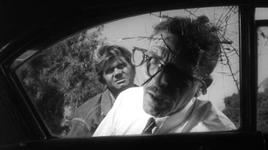
Itching to move on, Tibbs already has his
beady little inbred eyes on their car until Stiles warns
the fuel pump is shot. Knowing
they're all on borrowed time, he offers to
fix it -- with a hope to stall things
along until they can engineer an escape. Tibbs
agrees, but makes no secret of his
intentions to kill them all as soon as the
car's fixed. When Oliver, the eldest of
them, tries to reason with their captor, he only
gets pistol-whipped for it. Then, turning
a lecherous eye toward Doris, Tibbs
playfully uses her and Oliver for a little
target practice until Stiles refuses to do
any more work unless he leaves them alone.
But Judy has a better idea, anyway, and whispers
it into Charlie's ear. Liking the idea, he
makes Oliver get on his knees and beg for
his life; and he only has a narrow
window to make his case -- he has however
long it takes Tibbs to finish a bottle of
soda-pop before his life will end! And as
he knocks the bottle back, again and again,
Oliver's pleas for help from his friends
and mercy from the hoodlum prove
fruitless. The bottle soon empty, Tibbs
cocks the trigger and thrusts the gun
right into his victim's face!
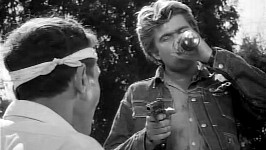
This
is the critical point in The
Sadist,
and it's a pivotal moment for the
audience, too. Things begin creepily
enough: there are plenty of ominous clues
that we're made aware of, as an audience,
but not our protagonists that something is
wrong --
the cut phone lines, signs of a
struggle, and just an overwhelming sense
that they're being watched by something.
Things quickly turn sinister, confirming
our suspicions, when a .45 is thrust on
screen, taking up the whole frame; then
the camera whirls around and we're
suddenly face to face with our
"sadist" -- whom we B-Movie
zealots quickly recognize as the
unmistakable mug of Arch Hall Jr. ... Arch's
performance as Charlie Tibbs is anything
but restrained, and over the top doesn't
even begin to do it justice. He strikes
odd poses with the gun, and his voice and
inflection come off as slightly retarded
as he starts to put our heroes through the
wringer, physically and emotionally. And
you get the first uneasy inkling that this
film is a different breed of J.D. thriller
when Tibbs goes through the groveling
Oliver's wallet, first tearing up his
baseball tickets, and then pictures of his
family. This sense of uneasiness is
reinforced when he accosts Doris and
actually sticks his hand up her shirt and roughly
cups a feel.
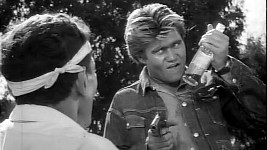
Whoa
-- What the hell? Can this truly be
happening? Is
Arch Hall Jr. actually being menacing? Well ...
Arch's ham-fisted delivery still has us
harkening back to his other juvenile
delinquent pictures, like The
Choppers,
and other authoritarian, albeit hilarious,
entries in this particular genre. I'll
admit, up to this critical point, I was
laughing at old Arch, too. With
that high-pitched voice and perpetual
squint, all topped off with that concrete
pompadour,
his performance, for some reason, was
reminding me of a young and pudgy Wayne
Newton (--
back when he was doing guest spots on Bonanza).
But
then we reach that pivotal moment when
Oliver's time runs out:
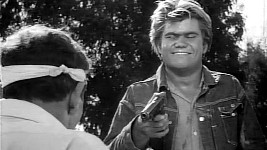
Ignoring the pleas
for mercy...
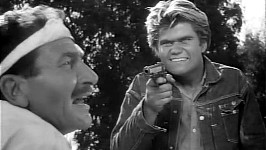
Tibbs, with the .45
in hand...

Sticks
it point plank in Oliver's face...
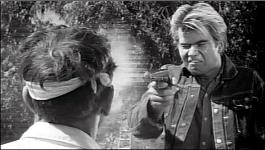
And
pulls the trigger.
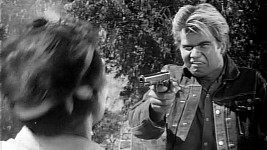
*Bang*
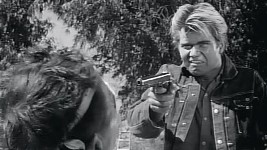
Holy
crap! What the hell just happened?
Like
Tibbs, the camera doesn't flinch. We see
the whole thing. Here, I'll
pause to remind everyone that this is
1963 we're talking about; and I'm
curious if this is the first time we
actually see someone get shot in the
head without the aid of a jump-cut.
And
after that extremely shocking moment,
everything afterwards, even though Arch's
character is doing the exact same things, and he's acting the exact same way,
everything that seemed silly and insipid
before honestly becomes chilling, and, in
some cases, downright terrifying!
In
an Arch Hall Jr. flick?! Are you kidding
me?!
No.
I'm not. And
I'll even take it one step further and say this
whole movie is pretty damned good, even though
it's become cliché, retroactively;
spoiled by a lot of
psycho-degenerate/white-trash serial
killer films that followed. Is that fair?
I don't think so. Some people are just
narrow-minded these days. And yeah, it is
hard to believe when you look at the
Arches' oeuvre as a whole ... See, Arch
Hall Jr. was the protégé of his father,
Arch Hall Sr. After getting out of the
military (--
and his time in the service as a test
pilot was actually made into a film by
Jack Webb, of all people, in The
Last Time I Saw Archie),
Senior became an independent movie
producer, mostly second-tier westerns. He
also served as writer and director on a
lot of his projects and eventually founded
his own company: Fairway International
Pictures. And in that capacity, he was
also responsible for giving Ray Dennis
Steckler his first directing gig (--
and god bless 'em for that! Arch Sr. also
produced Steckler's similar, but not quite
as effective, The
Thrill Killers.)
When
westerns began to fade at the box-office,
Senior switched his production-eye toward
the exploitation market and backed a
nudie-cutie written by Junior called The
Magic Spectacles.
Senior also saw the success that American
International Pictures was having with
their swinging beach party movies and hit
upon an idea...
All
Arch Hall Jr. ever really wanted to be was
a pilot, like his dad, but Senior got it
into his head that he could turn his son
into a crooning teen heartthrob -- a
cash-cow, and over the span of three short
years assaulted the drive-in circuit with
the critically low-budget
"classics" The
Choppers,
Wild
Guitar
and EEGAH!.
Each
movie proved successful enough to form the
budget for the next one. They're
all pretty terrible -- but a demented good
time, which probably explains why Arch
Hall Jr. never really took off.
With
all the perceived acting talent of an avocado,
coupled with musical talents that could
barely muster songs like "Kongo
Joe" and "Monkey in My
Hatband", Junior's career quickly
petered out with The
Nasty Rabbit
and Deadwood
'76.
He then gave up acting altogether, went
on to get his pilot's license, and became a
successful commercial aviator. Senior, who
had been a modestly successful independent
film producer, was crushed by this
development, and, according to Steckler in
the book
Research
10: Incredibly Strange Films,
was never the same. When Junior walked
away from the movie business, Senior
stopped producing, too, and the world of
B-movies is lesser for it. (Arch
Hall Sr. died in '76.)
At last report, Junior is still flying, is
a grandfather, and living in Florida but
declines most offers to discuss his film
career. I also understand that he's just
published a novel under one of his
father's many pseudonyms.
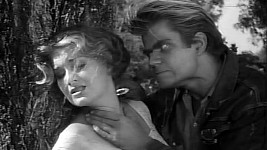
Right
in the middle of all that cinematic cheese
came The
Sadist,
but it was two other men, I believe, who should be
properly credited for elevating this movie above
the rest of the dreck: James Landis and
Vilmos Zsigmond. Arch Sr.
served only as the producer (--
and as the uncredited narrator, Nicholas
Merewether) on this flick, while
the writing and directing chores fell to
Landis. A veteran writer for the TV show Combat!,
Landis took the no-nonsense, documentary
approach of that show and applied it to The
Sadist.
As the first serious attempt to adapt the
Starkweather and Fugate murder spree on
film, Landis proved up to the task, and
his simple, matter-of-fact style resulted
in pretty taut thriller that will knock
you right on your ass because this is the
last thing you're expecting when you see
who's on the marquee. Zsigmond, here
billed as William Zsigmond, served as the
film's cinematographer, and his set-ups
and creative framing give The
Sadist
a certain frenetic look -- a razor-blade
starkness, and a down and dirty grittiness
that gives the film most of its cinematic
punch. He keeps switching perspectives:
one minute we are on one side of the gun
looking down the sight, the next we're
staring right down the barrel; it's simple
but effective in keeping us off balance.
There's a lot of effective handheld camera
work, too, getting us down in the dirt and
the middle of the action -- I swear the
camera barely gets over three-feet off the
ground for the majority of the picture,
and the frame never really does stand
still once the ball gets rolling, giving
this film a frenzied sense of momentum that
keeps things barreling toward the climax.
Zsigmond
is another one of those gifted craftsmen who
worked their way up the film food chain.
Breaking in with the Arches, he moved on
to work with Steckler for several
pictures, including The
Incredibly Strange Creatures who Stopped
Living and Became Mixed Up Zombies,
where he worked with two other famous
contemporaries, Lazlo Kovacs and Joseph
V. Mascelli; then Al Adamson's Satan's
Sadists, before graduating to
more mainstream work for the likes of Robert
Altman, John Boorman and Steven
Spielberg, and eventually, an Academy
Award for his craft with Close
Encounters.
He ran into a streak of bad luck after
that, though, with the critical and
box-office disaster Heaven's
Gate
and several Brian de Palma duds,
including Bonfire
of the Vanities. Now
back to the review!
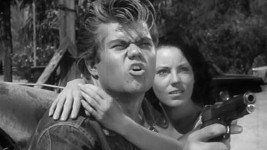
When
combining their efforts, here, these two
concoct a film that is relentless, brutal
and very downbeat that definitely deserves
more notoriety. So why don't more people
know about it? And why isn't it considered
a cult movie classic? Well,
with all respect to Arch and his gonzoid
performance, it is the cast that
ultimately sinks the film. Mention of a
positive nature should be made for Marilyn
Manning's equally understated
performance as Judy -- and it's hard to
believe that these two played the two
brain-dead teenagers in EEGAH!
just the year before. As Tibbs's deadly
muse, she seems to be the true trigger for
his homicidal outbursts. To her it's just
a game, and her sinister suggestions and
the scenes of her rifling the dead for
souvenirs is truly disturbing. So
that means the biggest problem lies with
our three protagonists. These characters
are paper thin to begin with and the
actors don't really add anything to them.
Russell fails as the voice of reason and
both he and Alden appear to have gone to
the William Shatner school of acting.
You'll occasionally catch a hint of an
accent from Hovey, a cousin of the film's
star. She's a gamer, but never acts like
she's in any real danger, like she hasn't
quite got the difference between acting
and pretending down yet, so some of the
menace is lost. And as the film plays out,
dare
I say Alden makes a better "final
girl" than she does? And to
be honest, there are no likeable
characters here. Well, Carl Oliver, maybe,
but he's already dead. I mean, Tibbs and
Judy, our thrill-killers, are sociopathic
vermin, and Stiles comes off as a
sniveling coward, while Doris is, well, as
I hinted before, Doris is kind of a
helpless cipher who you'll be yelling
"Run, ya idiot!" at. A lot.
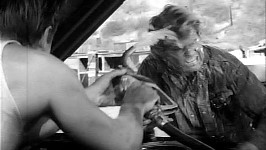
And
there are several chances to escape, or
take Tibbs on, but Stiles keeps wimping
out -- but it is a believable kind of
wimping out, so we can empathize with him
a little. The biggest chance to escape
comes when two passing motorcycle
patrolmen stop for some refreshments.
Alas, the protagonists wait too long to
warn them, letting Tibbs get the drop on
the cops, and he shoots them both dead. And
with each dashed hope and every missed
opportunity continuing to stack the deck
against our survivors' life-expectancy,
you're still conditioned to expect a happy
resolution -- but it never comes. Evil
isn't punished in the film. Evil only kind
of devours itself; a hollow victory for
the good guys. It
starts with a deft move by Stiles, who
finally summons the courage to act,
and then Tibbs, his face full of gasoline,
accidentally shoots and kills his partner
in crime. Up to this point, as I said
before, Stiles had
kinda been a cowardly weasel, but you
figure now that he's finally grown a pair,
he'll come through and save the day, thus
redeeming himself. And, like Stiles, I was
counting the number of shots while Tibbs
was chasing him. So after their harrowing
game of cat and mouse, when the gun clicks
empty and Stiles goes on the attack -- and
we as an audience look forward to seeing
Tibbs finally getting his head kicked in
-- we, like Stiles, forgot about the
stolen police revolver, and then sit in
stunned silence when Tibbs pulls the
second gun and drops his latest victim before he can
even get close. And there will be no
last-second heroics by a wounded Stiles,
either, as Tibbs empties the revolver into
him, punctuating that point with a
gruesome finality.
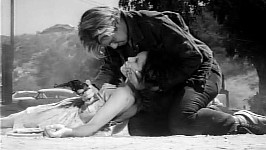
Then, after another prolonged
stalk and chase scene (-- that
we'll be seeing again twenty years later
in Texas, if you know what I mean),
Doris is saved by dumb luck and dumb luck
only when Tibbs falls into an abandoned
well, a den for several rattlesnakes,
which robs of us of any kind of emotional
payoff. And we end with Tibbs's death
screams (-- that purposefully sound
like a dying animal --) as Doris, in a
state of shock, slowly wanders back toward
the junkyard as those resonating, primal
shrieks fade to be replaced by the radio
call of the baseball game.
And
that is why you'll have a hard time
shaking The
Sadist
once you've seen it, because you're angry
at it -- and in hindsight, respecting the
hell out of it -- for cheating us out of
any kind of vindicated resolution. Just
one of the many reasons why The
Sadist
truly is a remarkable and groundbreaking
piece. And its influence can be seen in
the relentless, cynical and brutal horror
films of Craven, Hooper and many others in
the 1970's and should be championed for
this and not lampooned because if its
leading man. Facts is facts: The
Sadist
was the first of it's kind, and definitely
deserves to be better known than it is.
|